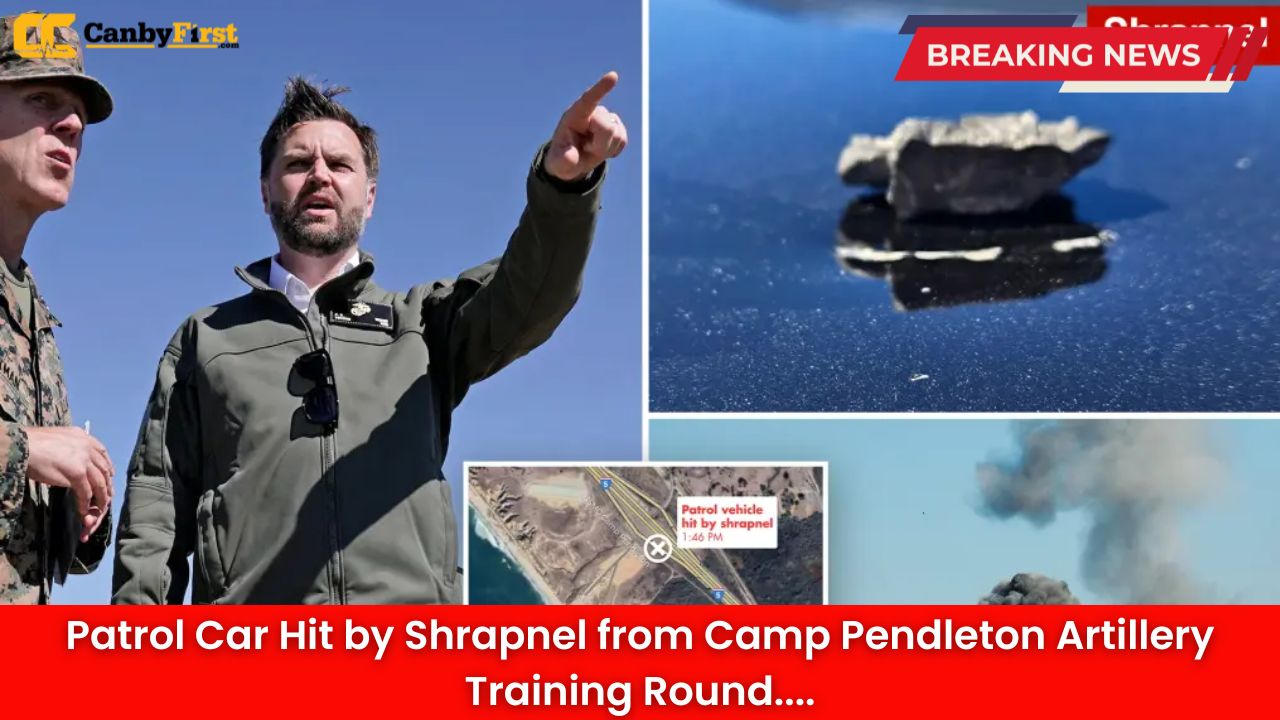A routine evening patrol turned into a dangerous encounter on Sunday when a local law enforcement vehicle was struck by shrapnel from a live artillery round fired during a training exercise at Marine Corps Base Camp Pendleton, authorities confirmed. The incident sparked an immediate investigation and renewed discussions on the safety of live-fire military training near civilian zones.
Sudden Blast Jolts Coastal Highway
According to early reports, the San Diego County Sheriff’s Department patrol unit was driving along Highway 76, roughly three miles east of Camp Pendleton’s perimeter, when what appeared to be metallic debris pierced the side of the vehicle. The explosion-like impact caused minor damage to the cruiser’s exterior but, remarkably, no injuries to the deputy inside.
Witnesses reported hearing a deep echoing boom moments before seeing fragments scatter near the roadside. Several drivers briefly stopped, fearing an explosion unrelated to the Marine base’s known training drills.
Also Read
“It sounded like thunder at first, then something slammed into that patrol car,” one witness said. “It was shocking to see shrapnel flying that close to the highway.”
Marines Confirm Artillery Misfire Incident
A spokesperson for Camp Pendleton confirmed late Sunday that a 155mm artillery round fired during a scheduled training exercise inadvertently released shrapnel beyond the base’s designated impact zone. Military safety teams immediately ceased operations and initiated a full review.
“During a live-fire training event, a single round experienced an irregular fragmentation pattern,” the Marine Corps statement read. “Safety protocols were enacted immediately. The Marine Corps is cooperating fully with local law enforcement and is conducting an internal investigation to determine the cause.”
Personnel from the Marine Corps Explosive Ordnance Disposal (EOD) unit were dispatched to examine the area where the debris landed. Although no explosives were found in the surrounding fields or roadways, officials urged nearby residents to avoid any suspicious metal fragments.
Law Enforcement Response and Safety Review
The San Diego County Sheriff’s Department confirmed that the incident occurred just before 5 p.m., close to the eastern boundary of the base. The patrol car involved was inspected by bomb technicians to ensure no hazardous materials were present. Preliminary findings suggested that the shrapnel was consistent with fragments produced by high-explosive artillery shells used in standard Marine Corps training.
Sheriff Anthony Ray assured residents that the situation posed no continuing threat but emphasized that the department takes the incident seriously.
“Our deputies patrol near Camp Pendleton daily, and safety has always been a cooperative effort between our office and the Marine Corps,” Ray said. “No one was hurt, and that’s a relief, but we expect thorough answers on how this happened.”
Residents Voice Concerns About Ongoing Military Drills
This is not the first time live-fire exercises at the sprawling 125,000-acre base have raised public concern. Local residents of Oceanside and Fallbrook have long reported hearing concussive sounds and feeling the vibration of artillery fire during training periods.
“Most of us are used to the booms, but this felt different,” said longtime Oceanside resident Paul Delgado. “If shrapnel can reach the highway, that’s too close for comfort. We need better safeguards.”
The City of Oceanside stated that it would coordinate with both the Sheriff’s Department and base officials to ensure clear communication about future drills, particularly those involving artillery or mortar fire.
Military Procedures and Risk Boundaries
Camp Pendleton, one of the Marine Corps’ largest operational training grounds on the West Coast, regularly hosts combined-arms exercises involving infantry, tanks, and artillery units. To contain live-fire effects, the installation maintains clearly designated impact areas surrounded by safety buffers — zones intended to prevent projectiles or fragments from reaching civilian spaces.
Experts note that, while such accidents are rare, they can occur when elevation, weather conditions, or weapon calibration deviate unexpectedly. In similar past cases, studies found that crosswinds or minor miscalculations in trajectory could push fragments beyond intended boundaries.
A retired Marine Corps gunnery sergeant familiar with Camp Pendleton’s training ranges explained, “These exercises are tightly monitored, but no system is foolproof. The key is reviewing what variables changed — was it weather, equipment, or human error?”
Ongoing Investigation and Preventive Measures
Base officials stated that training on the affected range would remain suspended pending the results of a joint review board composed of Marine Corps safety experts, ordnance engineers, and local law enforcement representatives. The board will analyze telemetry data, round specifications, and firing logs to determine whether improper range clearance or a malfunction caused the errant debris.
If confirmed as a trajectory miscalculation, the investigation could lead to new restrictions on live-fire zones or temporary relocation of high-explosive drills further inland within Camp Pendleton’s boundaries.
Meanwhile, the Sheriff’s Department said it is working with county officials to document the property damage and will provide the findings to federal authorities before any civil claims are reviewed.
Regional and Political Reactions
Several local leaders have already called for transparency and improved communication with surrounding communities. San Diego County Supervisor Jim Desmond, whose district includes portions of land adjacent to Camp Pendleton, urged the Department of Defense to ensure the “immediate re-evaluation of range safety maps.”
“We are proud to have the Marine Corps here,” Desmond said, “but the public deserves full confidence that training exercises will not endanger lives or property beyond the fence line.”
Governor Gavin Newsom’s office acknowledged awareness of the event and requested a brief from military officials. Federal defense officials in Washington said they are awaiting Camp Pendleton’s formal report but noted that no live-fire suspension beyond the base is planned at this time.
No Injuries, but Close Call Sparks Debate
Although no one was injured in Sunday’s incident, the near-miss underscored the delicate balance between national defense training needs and public safety. For decades, Camp Pendleton has been a cornerstone of Marine combat readiness, and such exercises are integral to maintaining operational standards.
Still, for residents near the base, the event served as a stark reminder that even a single misdirected fragment can raise large-scale safety and trust concerns.
“Today we were lucky,” Oceanside Mayor Esther Sanchez remarked. “But we cannot rely on luck. We need clear assurances this won’t happen again.”
FAQ
What exactly happened near Camp Pendleton?
A law enforcement patrol car was struck by metal shrapnel from a Marine Corps artillery round fired during a training exercise. There were no injuries.
Was the officer inside the car injured?
No, the deputy driving the vehicle escaped unharmed, though the cruiser sustained minor damage.
Is the military halting training activities?
Yes, training on the specific range where the incident occurred has been paused pending investigation.
Could this happen again?
Officials say such incidents are rare, but additional safety measures and adjustments to boundaries are being reviewed to prevent recurrence.
Will the public be updated?
Both the San Diego County Sheriff’s Department and Camp Pendleton have committed to releasing further details once the investigation concludes.












